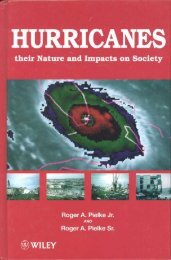Equivalent temperature - Climate Science: Roger Pielke Sr.
Equivalent temperature - Climate Science: Roger Pielke Sr.
Equivalent temperature - Climate Science: Roger Pielke Sr.
Create successful ePaper yourself
Turn your PDF publications into a flip-book with our unique Google optimized e-Paper software.
<strong>Roger</strong>s Airport on the city's southwest side. Urban land<br />
covers are present on the southwest edge of the Will<br />
<strong>Roger</strong>s Airport site, but grassland rings the site's north,<br />
east, and south edges (Fig. 9b).<br />
A comparison of the annual cycle of trend differences<br />
for Oklahoma City (Fig. 10) andWashington(Fig. 8)<br />
reveals some similar patterns. To be more specific, winter<br />
and early spring show mixed differences, the summer<br />
shows TE trends that are relatively warmer, and fall shows<br />
TE trends that are relatively cooler than T trends. For<br />
Oklahoma City, however, the period of time in the spring<br />
and summer for which TE trends are relatively warm<br />
compared to T trends which is more pronounced, while<br />
the period of relatively cooler trends for T E in the fall is<br />
smaller.<br />
Minot, North Dakota, is also located in a grassland<br />
environment, large tracts of which have been converted to<br />
agricultural production of small grains such as wheat.<br />
Minot Air Force Base is almost exclusively urban (Fig.<br />
11a) as every cell in the site grid is so classified. The site at<br />
Minot International Airport (Fig. 11b) has a small amount<br />
of urban land cover on its southwestern edge. Everything<br />
else, however, is covered with small grains agriculture<br />
(land cover #7).<br />
The seasonal patterns for the Minot sites (Fig. 12)have<br />
some unique characteristics compared to the previous two<br />
cities. First, the TE trends are not relatively warmer than<br />
the T trends until the early summer months. Second, the<br />
fall months do not strongly indicate that the T E trends are<br />
relatively cooler than the T trends.<br />
Finally, we consider two sites located on the southwestern<br />
edge of Miami, Florida. One site is the Miami/<br />
C.A. Davey et al. / Global and Planetary Change 54 (2006) 19–32<br />
Fig. 12. Same as in Fig. 8, but for Minot Air Force Base (grey bars) and Minot International Airport (cross-hatched bars).<br />
Kendall New Tamiami Airport near Kendall, Florida, and<br />
is characterized by urban land covers over all but its<br />
eastern sectors (Fig. 13a). Water (land cover #10) is present<br />
in the southeast sector, with row crops (land cover #6)<br />
in the east sector and other miscellaneous land cover to the<br />
northeast (land cover #11). The other site is at Homestead<br />
Air Force Base in Homestead, Florida. This site has extensive<br />
row crops everywhere except the northwest sector,<br />
which is urban (Fig. 13b).<br />
The annual cycle of the ΔTE−ΔT trend differences<br />
(Fig. 14) at both sites show that TE trends are relatively<br />
warmer during the winter and spring months but then<br />
become relatively cooler during the late fall. The December<br />
trends for Homestead Air Force Base were not available for<br />
this analysis. Compared to the eastern United States as a<br />
whole, however, the peak of the warm ΔTE−ΔT differences<br />
occurs earlier, towards the spring months rather<br />
than the summer months. The cool differences in the fall are<br />
Fig. 13. Same as in Fig. 7, but for New Tamiami Airport (a) and<br />
Homestead Air Force Base (b).<br />
29














